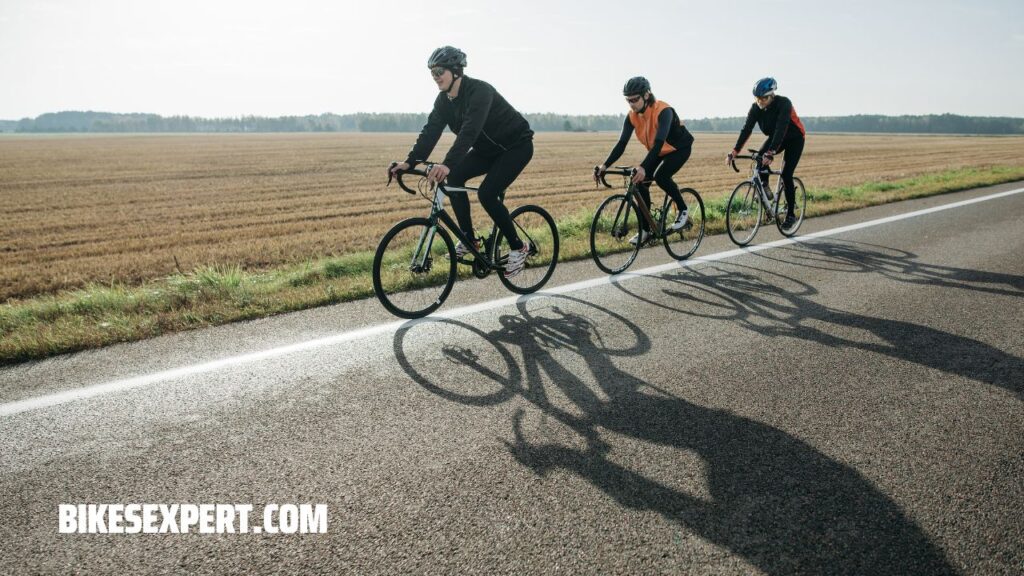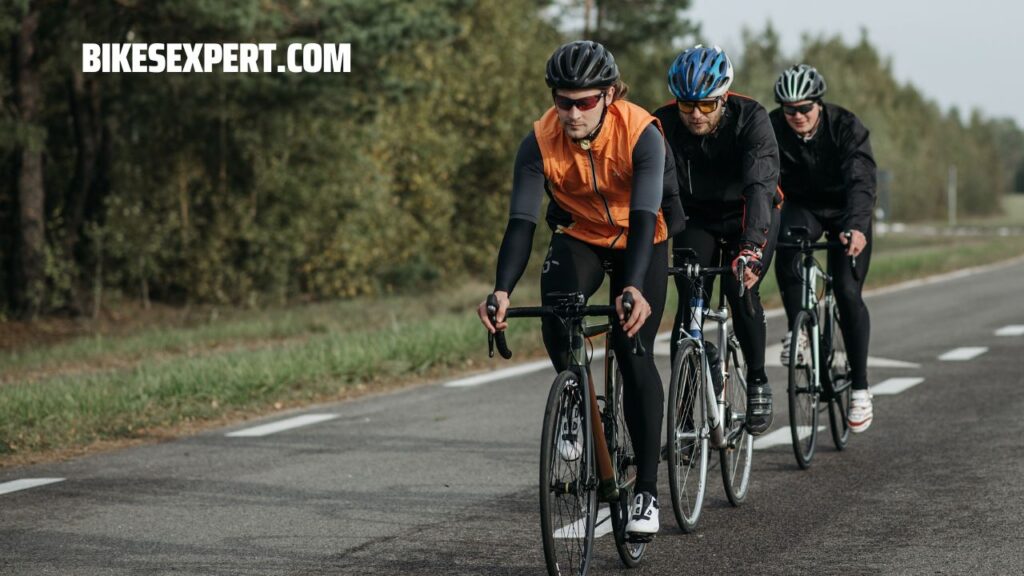Mountain bikes and road bikes are both types of bicycles, but they are designed for different types of riding.
Mountain bikes are built for off-road riding on rough terrain, with features such as wider tires with aggressive treads, suspension, and a sturdy frame.
Road bikes are designed for speed and efficiency on paved roads, with features such as narrow tires, lightweight frame, and dropped handlebars. They generally have lighter weight and fewer features than mountain bikes as they are built for speed.
Choosing between the two depends on what type of riding you plan to do. If you plan to ride on paved roads, a road bike might be a better choice. If you plan to ride off-road, a mountain bike is more appropriate.
We have a related article for you, you can read Can You Ride A Mountain Bike On A Road? Important!
What Makes A Road Bike Different From A Mountain Bike?

The fundamental distinction is one of speed and endurance. A road bike is designed for riding longer distances at greater speeds, but an MTB is designed for riding off-road and is less appropriate for long trips. However, both have many gear and pieces built for specific uses.
Both road bikes and mountain bikes are classified as separate kinds of bikes. A road bike is ideal for long-distance riding while maintaining pace.
Mountain biking is perfect for adrenaline seekers who like getting muddy. But it could be more complex. So I started to delve into the differences and discovered several distinctions.
Performance & Purpose
Mountain bikes are intended for usage off-road (trails, tracks, mud, snow) and function poorly on streets and pavements. You may, however, change the tires and utilize a slicker profile to get better street performance. Road bikes are designed for speed and long distances; a mountain bike will need help to keep up with a road cycle.
Road bikes are quicker and more efficient on asphalt and pavement. However, a road bike is not designed to handle difficult terrain and will suffer greater wear and tear if used on a trail. In addition, due to the absence of suspension, it’s an uncomfortable and unsteady ride.
Road bikes are lightweight and (depending on the model) fast. A road bike’s posture is quite different; riders sit forward-leaning to boost aerodynamics. This also enables greater power to be transferred to the paddles.
There is also a weight differential depending on the bike; road bikes are often lighter than maintenance bikes. Of course, I’m not talking about high-end carbon mountain bikes, typically incredibly lightweight, but a road bike weighs significantly less.
Mountain Bikes vs. Road Bike Gearing

The principal difference is due to differing gears and bike components. Mountain bikes use suspension to mitigate shocks while riding on rough terrain.
The tires are wider and have knobby profiles to help with grip on rocks and mud. Road bikes have a smooth design that makes them
quicker, yet they serve fundamentally different objectives. I recommend a cross-country bike if you want something ideal for riding off-road.
Rear Cassette
Road bikes often have a smaller rear cassette than mountain bikes. Touring road bikes are the sole exception. Road bike cassettes contain more distinct gears, and the hub springing is deeper to handle higher pressures.
Mountain bike cassettes contain many gear groups on the carrier to transfer forces better equally. Weight is also saved by shortening the splines.
Front Derailleurs
Modern mountain bikes often have just two chainrings, although road cycles frequently have three. This also implies that you can’t change out the crankset; an MTB crankset will not fit on a road cycle, and vice versa.
I would only attempt that if it results in growing complications. Because a road bike has more chainrings, it may shift into a higher gear, allowing for faster acceleration.
Wheels & Tires
Mountain bike wheels are typically smaller and stronger than road bike wheels. They’re also much broader than road bikes and have different tire profiles.
Road bike wheels aren’t as broad as MTB wheels, so there’s less surface friction, and you can go faster with less effort.
Handlebars
Handlebars are designed and shaped differently. MTB handlebars are broad and flat, while road bikes have drop bars.
Flat handlebars are said to provide better control and make braking with one finger simpler. Some argue that flat bars are preferable for climbing, although they put greater pressure on the wrists. Drop handlebars are narrower, making it simpler bike fit through tight spaces.
Forks
Mountain bike forks are stronger and beefier since they must withstand high stresses while remaining intact.
Suspension is used on most mountain bikes to absorb shocks. Road bikes often lack this function, while suspension-equipped road bikes are available.
Pedals
I’m not talking about standard pedals here. MTB paddles and road bike pedals are very different. Road bikers often utilize mountain bike pedals, but there are variations. Both contain a mechanism that keeps your shoes from sliding off the paddle.
The size of the cleat affixed to the shoe sole is the difference. Mountain bike pedals feature tiny cleats that are easy to release.
This makes sense since falling off a mountain bike when riding trails is more common, and it would be a far more unpleasant experience if you couldn’t unlock it. In addition, road bikes
feature bigger cleats that increase the surface area of contact between the shoe sole and the pedals.
Mountain bikes, like road cycles, have flat pedals; it all depends on your tastes.
Breaks
Road bike brakes have a shorter draw than mountain bike brakes. Mountain bikes often feature V-brakes or mechanical disc brakes, but road bikes generally use the mechanical disc, caliper, or cantilever brakes.
When mountain biking, using the brakes is more often, but you don’t want to come to a complete stop too soon. When you’re going to strike an obstruction, it’s often a question of altering your speed and accelerating again.
Types Of Road Bikes And Mountain Bikes

Creating a comprehensive comparison is difficult since many kinds of road and mountain bikes
exist. Each sort of bike is created for distinct situations and styles, and even then, there are minor differences.
For example, some bikes are built for speed, travel, comfort, or brutal shredding. I won’t go into detail on each road and mountain bike, but here’s the idea.
Types of Road Bikes
- Race bikes are lightweight and completely pared down to be as light as possible. Their design is aerodynamic and prioritizes speed above comfort. The frames have been stiffened, and the wheels have been made slimmer. Not ideal for traveling or hilly terrain.
- Gravel bikes can ride off-road terrain and trails while maintaining speed on prolonged trips. Their frames are stronger and can handle difficult terrain, and their forks have more clearance, allowing for wider and knobblier tires.
- Endurance bikes are designed for long-distance travel and endurance. This is the style of bike seen in mass cycling competitions, and the geometry provides more comfort.
- Touring bikes are ideal for long-distance travel and provide a pleasant ride. Not designed for speed or racing but rather for durability.
Types Of Mountain Bikes
- Cross Country (XC) is the most prevalent mountain bike and is ideal for riding trails for extended periods.
- Trail mountain bikes are ideal for experienced riders who like riding trails and tracks. They are available in single and full suspension, with the former being less expensive.
- Enduro bikes are full-suspension bikes that are often used on trails. These are often high-end and costly motorcycles.
- Downhill mountain bikes are designed for tough terrain, particularly downhill. They’re not designed to ascend but rather to descend through tough terrain and hard obstacles.
Frequently Asked Questions[FAQs]
What Is The Difference Between A Road Bike And A Mountain Bike?
It’s not an issue of which bike is easiest to ride. For example, a mountain bike is more comfortable for you since a road bike demands you to sit in a forward-leaning posture. This is also true while riding a mountain bike; however, it is less intense.
Is It True That A Road Bike Is Faster Than A Mountain Bike?
Road bikes are built for speed and distance travel. They are quicker on tarmac and asphalt but cannot compete with mountain bikes off-road.




